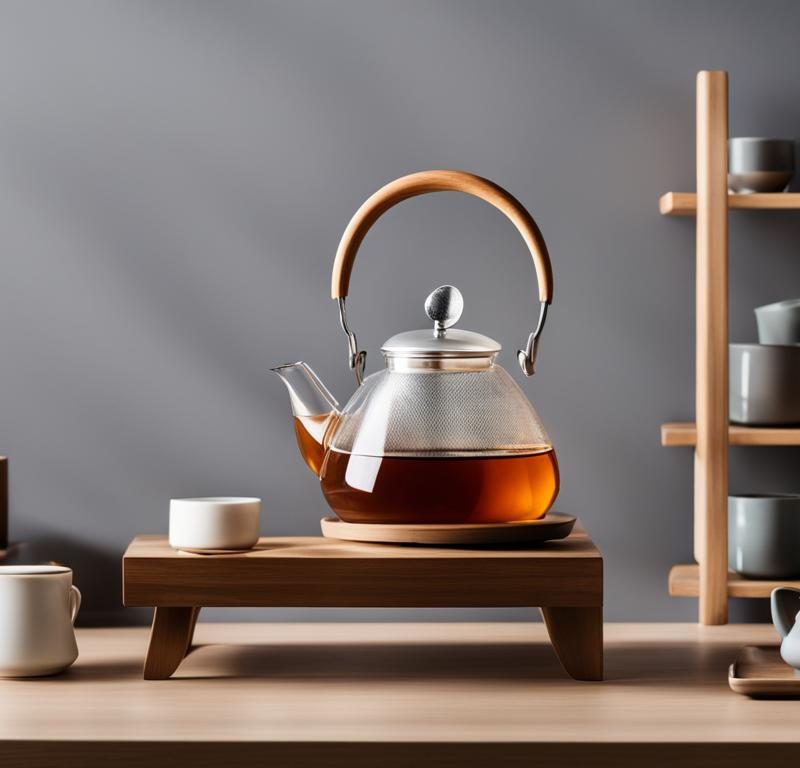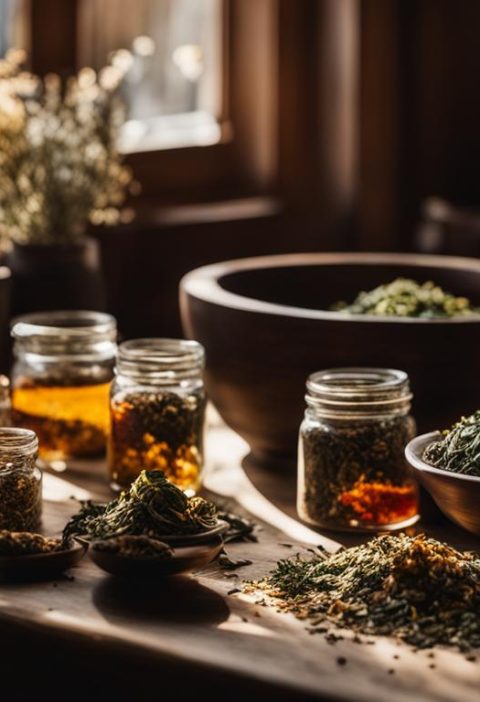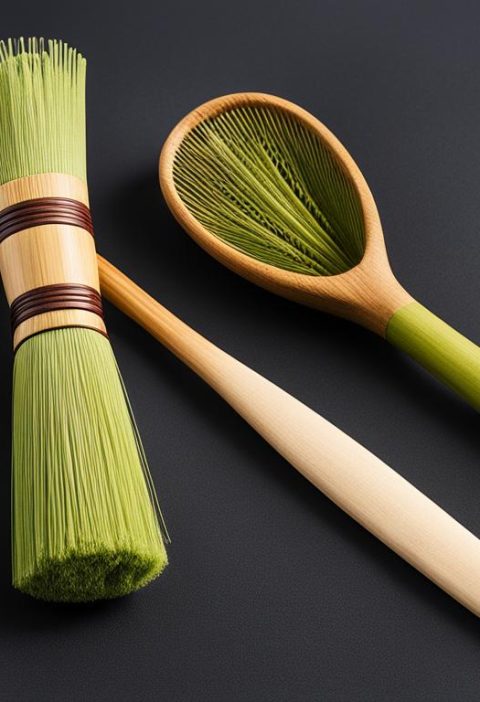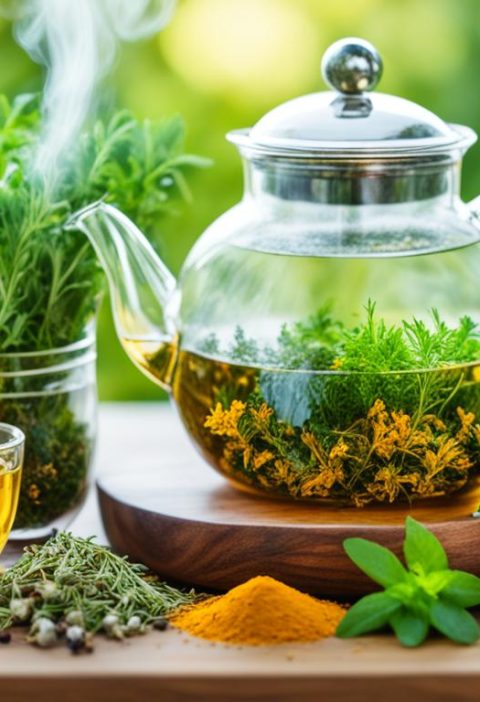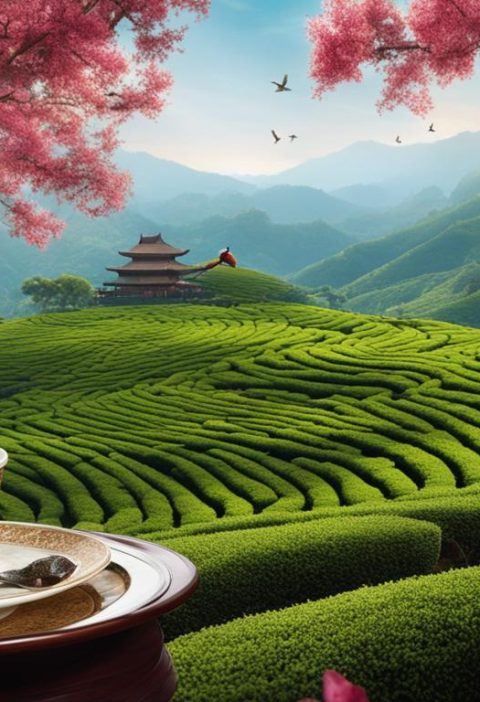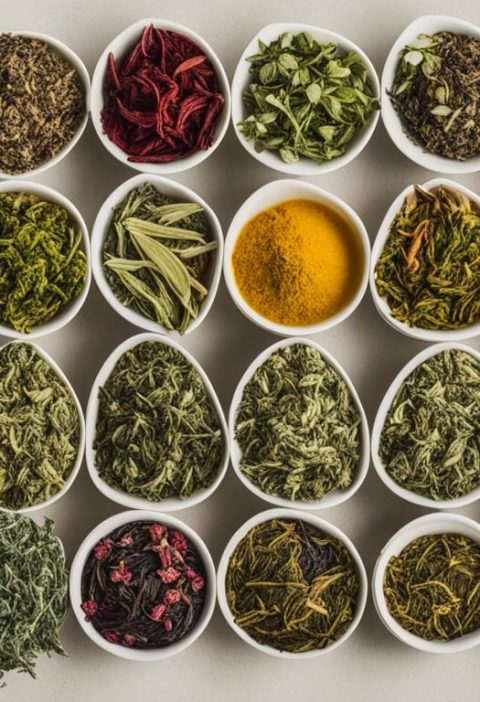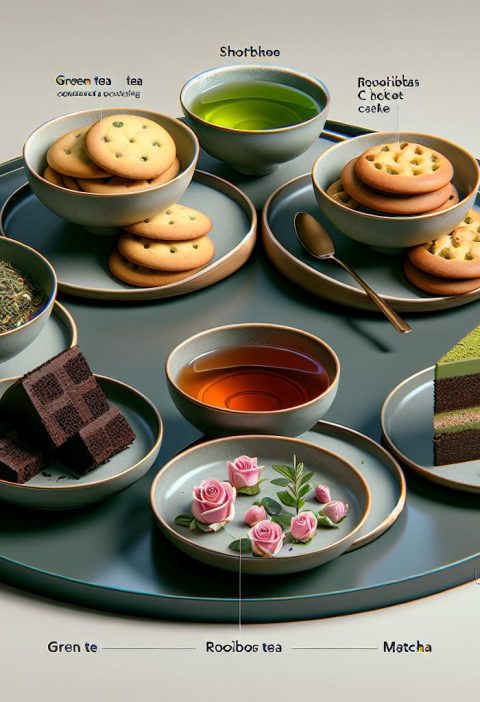Brewing the perfect cup of tea is a delightful and rewarding experience. Whether you’re a tea enthusiast or a casual tea drinker, having the right tea brewing setup can elevate your tea-drinking experience to new heights. In this comprehensive guide, we will walk you through the essential tips and techniques to create the ultimate tea brewing setup at home. From tea quality and storage to tea temperature and steep time, we’ll cover everything you need to know to brew tea like a pro.
Key Takeaways:
- Invest in high-quality tea leaves or blends for superior flavor.
- Store loose leaf teas in airtight packaging to preserve freshness.
- Use the recommended tea-to-water ratios for each type of tea.
- Adjust the water temperature based on the tea type for optimal flavor.
- Follow the recommended steep time to extract the desired flavors.
Tea Quality and Storage
The quality of the tea used in the brewing process significantly impacts the flavor of the final cup. To ensure a delightful tea experience, it’s essential to prioritize tea quality and proper storage.
Fresh, high-quality tea leaves or blends are the foundation for a superior flavor profile. These teas are carefully crafted and sourced to maintain exceptional taste and aroma. When purchasing tea, look for reputable brands that prioritize quality sourcing and processing.
However, even the highest quality tea leaves can lose their flavor and freshness if not stored correctly. Tea storage plays a pivotal role in preserving the delicate flavor and aroma. To protect your tea from moisture, light, and other elements that can degrade its quality, it’s crucial to store loose leaf teas in airtight containers.
Using airtight packaging, such as resealable tea tins or glass containers, helps maintain the tea’s flavor and prolong its shelf life. These containers create a barrier that prevents moisture and air from entering, preserving the tea’s freshness and distinct flavor.
Additionally, it’s important to keep tea away from strong odors that can be absorbed and alter its taste. Store tea in a cool, dry place, away from spices, coffee, or other aromatic substances that could compromise its delicate flavors.
Proper tea storage allows you to savor the full flavor and benefits of your favorite teas, ensuring that each cup is a delightful experience.
Preserving tea quality through proper storage is a crucial step in crafting the ultimate tea brewing setup. By prioritizing tea quality and implementing effective storage practices, you can enjoy a consistently flavorful cup of tea with every brew.
Now, let’s explore the importance of tea quantity and ratios in Section 3.
Tea Quantity and Ratios
When it comes to brewing the perfect cup of tea, getting the right quantity and ratios is essential. The amount of tea you use depends on the type of tea you’re brewing. Different teas have varying densities and caffeine contents, which influence the recommended tea-to-water ratios.
Herbal, red, and rooibos teas generally require more tea per cup compared to green, white, or black teas. This is because their dense leaves or blends contain higher levels of caffeine and other compounds that contribute to their robust flavors. To properly enjoy these teas, it’s crucial to follow the recommended tea-to-water ratios to achieve the desired taste profile.
Here are the recommended ratios for brewing tea:
- For caffeinated teas: Use one teaspoon of tea for every six ounces of water. This ratio provides a balanced flavor for your cup of tea.
- For herbal teas: Use one tablespoon of tea for every eight ounces of water. This slightly higher ratio ensures the bold flavors and herbal qualities are properly extracted.
By following these tea-to-water ratios, you’ll be able to achieve the ideal balance of flavors and create a delightful tea experience every time.
Tea Temperature
When it comes to brewing tea, temperature is a crucial factor in extracting the optimal flavor. Different teas require specific temperatures to achieve the perfect brew. While some teas can withstand high temperatures, others are more delicate and can be easily ruined by overheating. To avoid bitter flavors or under-extracted tea, it’s essential to use the appropriate temperature for each tea variety.
A Quick Guide to Tea Brewing Temperatures
Here’s a breakdown of the optimal brewing temperatures for different types of tea:
| Tea Type | Optimal Brewing Temperature |
|---|---|
| Black Tea | 180-212°F (82-100°C) |
| Green Tea | 160-180°F (71-82°C) |
| White Tea | 160-180°F (71-82°C) |
| Oolong Tea | 190-200°F (88-93°C) |
| Herbal Tea | 180-212°F (82-100°C) |
These temperatures serve as a general guideline, but keep in mind that some teas may have specific temperature requirements. For instance, certain herbal teas, like chamomile or peppermint, might benefit from brewing with room temperature water. Always refer to the specific brewing instructions provided for each tea type to ensure the best results.
Monitoring and controlling the water temperature is crucial for achieving the desired flavor and avoiding any unpleasant taste notes. Using a digital thermometer or an electric kettle with temperature control can help you maintain the optimal brewing temperature consistently.
Why Tea Temperature Matters
The temperature at which you brew your tea directly affects the extraction of flavors from the tea leaves. Tea leaves contain a variety of compounds that contribute to its unique taste profile, such as catechins, polyphenols, and volatile oils. Different compounds are released at different temperatures, which is why brewing temperature plays a crucial role in balancing flavors.
Brewing tea at too high a temperature can result in a bitter taste due to the release of excessive tannins. On the other hand, brewing at a low temperature may result in an under-extracted tea with a weak flavor profile. By adhering to the recommended brewing temperatures, you can ensure a well-balanced, flavorful cup of tea every time.
Source: TeaSource
Tea Steep Time
When it comes to brewing tea, the steep time is crucial in extracting the full flavor profile of each tea type. Whether you’re brewing caffeinated teas or herbal infusions, understanding and following the recommended steep times will ensure a delightful tea drinking experience.
Steeping caffeinated teas for too long can result in bitterness and overpowering flavors. On the other hand, herbal teas, red teas, and rooibos teas can handle longer steep times without negative effects, allowing you to fully extract their vibrant flavors and beneficial compounds.
To help you achieve the perfect cup of tea, we’ve compiled a list of recommended steep times for different tea types:
| Tea Type | Steep Time |
|---|---|
| Green Tea | 2-3 minutes |
| Black Tea | 3-5 minutes |
| Oolong Tea | 3-4 minutes |
| White Tea | 3-5 minutes |
| Herbal Tea | 5-7 minutes |
| Red Tea | 5-7 minutes |
| Rooibos Tea | 5-7 minutes |
Remember that these steep times are general guidelines, and you can adjust them based on your personal preference. If you prefer a stronger flavor, you can prolong the steeping duration slightly. Conversely, if you prefer a milder taste, you can reduce the steep time. Experiment and find the optimal steep time that suits your palate.
Next, let’s delve into the techniques required to brew loose leaf tea to perfection. We’ll explore the best practices for measuring, water temperature, and brewing methods to ensure you can savor the full potential of your tea leaves.
How to Brew Loose Leaf Tea
To brew loose leaf tea, you only need a few simple steps. Follow our guide below to create the perfect cup of tea:
- Step 1: Prepare the Loose Leaf Tea
Measure the desired amount of loose leaf tea according to your taste preference. This can vary depending on the type of tea and your desired strength. Fill a tea infuser or disposable filter with the measured tea leaves. - Step 2: Heat the Water
Heat water to the recommended temperature for the specific type of tea you are brewing. This may vary for different types of tea, such as green, black, or herbal teas. - Step 3: Steep the Tea
Place the filled tea infuser or filter into your teacup or teapot. Pour the hot water over the tea leaves, allowing it to steep for the appropriate time. The steeping time can vary depending on the type of tea and the desired strength. - Step 4: Remove the Infuser or Strain
After the desired steeping time, remove the tea infuser or strain the tea leaves from the liquid to avoid over steeping. This will ensure a balanced flavor and prevent any bitterness.
Remember, brewing tea is a personal experience, and you can adjust the steeping time and water-to-tea ratios to suit your taste preferences. Enjoy your freshly brewed loose leaf tea!
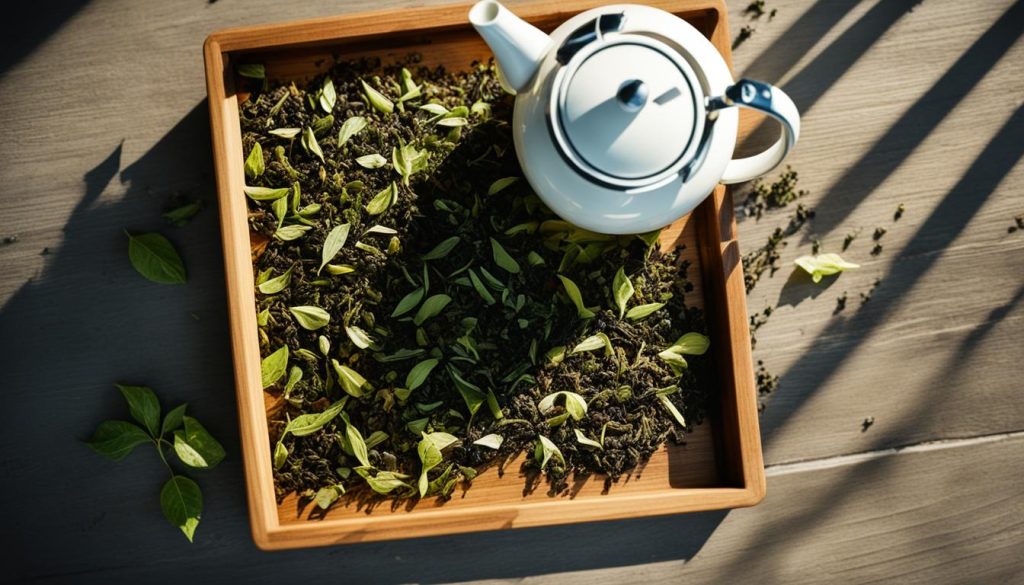
How to Brew Herbal Teas
When it comes to brewing herbal teas, there are two main methods: infusions and decoctions. The choice between these two techniques depends on the desired outcome and the specific herbs being used.
Hot Infusions
Hot infusions are ideal for extracting the flavors and medicinal properties of the aerial parts of plants such as leaves and flowers. This method involves steeping the herbs in hot water for a specified time to release their essences and create a flavorful tea. You can use a tea infuser or disposable filter to contain the herbs during steeping. After the recommended steep time, remove the herbs and enjoy your herbal tea infusion.
Decoctions
Decoctions, on the other hand, are better suited for hard plant parts like roots, barks, dried berries, and seeds. This method requires simmering the herbs in water for a longer duration to extract their beneficial compounds. To make a decoction, add the herbs to a pot of water and bring it to a boil. Then, reduce the heat and let it simmer for the recommended time. After simmering, strain the liquid to remove the herbs and savor the rich flavors of your herbal tea decoction.
By mastering the art of brewing herbal teas through infusions and decoctions, you can unlock the full potential of these natural remedies. Experiment with different herbal combinations and steeping times to discover your favorite blends and enjoy their soothing benefits.
| Method | Best for | How to Brew |
|---|---|---|
| Hot Infusions | Aerial parts of plants (leaves, flowers) | – Place herbs in a tea infuser or disposable filter – Pour hot water over the herbs – Steep for the recommended time – Remove the herbs and enjoy |
| Decoctions | Hard plant parts (roots, barks, dried berries, seeds) | – Add herbs to a pot of water – Bring to a boil – Simmer for the recommended time – Strain the liquid to remove the herbs – Savor the flavors |
How to Brew Caffeinated Teas
When it comes to brewing caffeinated teas like black, green, and white teas, each type has its own unique characteristics and requires specific brewing methods. Follow these steps to ensure you brew the perfect cup of caffeinated tea every time.
Tea-to-Water Ratios
Start by using the appropriate tea-to-water ratios. The ratios may vary depending on personal preference and the strength of flavor desired. As a general guideline, use approximately one teaspoon of loose leaf tea per six ounces of water. Adjust the amount of tea used based on personal taste preferences.
Water Temperature
Water temperature plays a crucial role in brewing caffeinated teas. To extract the optimal flavors, different types of teas require specific water temperatures:
- Black Tea: Brew with water heated to around 200-212°F (93-100°C).
- Green Tea: Use water heated to 175-180°F (79-82°C) for a delicate and refreshing brew.
- White Tea: Brew with water heated to 160-175°F (71-79°C) to appreciate the subtle flavors.
Steeping Time
The steeping time also varies depending on the type of tea:
- Black Tea: Steep for 3-5 minutes to extract bold and robust flavors.
- Green Tea: Steep for 1-3 minutes to enjoy a lighter and grassy profile.
- White Tea: Steep for 2-3 minutes to savor delicate and floral notes.
Remember to adjust the steeping time slightly to suit your personal taste preferences. Experimentation can lead to finding the perfect balance and flavor profile.
Removing Tea Leaves or Straining
Once the tea has steeped for the recommended time, remove the tea leaves or strain the brewed tea. This step is crucial in preventing over-extraction and bitterness in your cup. Using a fine mesh strainer or tea infuser, separate the liquid from the leaves.
Now that you know the basics of brewing caffeinated teas, you can confidently experiment with different teas and refine your brewing technique to create the perfect cup of tea each time.
| Tea Type | Water Temperature (°F) | Steeping Time (minutes) |
|---|---|---|
| Black Tea | 200-212 | 3-5 |
| Green Tea | 175-180 | 1-3 |
| White Tea | 160-175 | 2-3 |
How to Brew Red and Rooibos Teas
When it comes to brewing red tea and rooibos tea, there are a few key considerations to keep in mind. These teas require higher heat and longer steep times compared to other varieties, resulting in a robust and flavorful brew. Let’s explore the step-by-step process for brewing these delightful teas.
Step 1: Gather Your Ingredients
Before you start brewing, gather the following ingredients:
- Red tea leaves or rooibos tea
- Boiling water
Step 2: Measure the Tea
Measure the desired amount of red tea leaves or rooibos tea according to the recommended ratios. For a single cup, use approximately 1 teaspoon of tea.
Step 3: Heat the Water
Bring the water to a rolling boil. Red tea and rooibos tea benefit from the high heat to extract their full flavors.
Step 4: Steep the Tea
Place the measured tea leaves in a teapot or a heatproof vessel. Pour the boiling water over the tea leaves, ensuring they are fully submerged. Allow the tea to steep for the appropriate time to achieve the desired strength. Typically, red tea and rooibos tea require a steeping time of 5-7 minutes.
Step 5: Strain and Serve
Once the steeping time is complete, strain the tea leaves or remove the infuser from the vessel. Pour the brewed tea into a cup and savor the rich flavors of your red tea or rooibos tea.
| Tea Type | Water Temperature | Steeping Time |
|---|---|---|
| Red Tea | Boiling water | 5-7 minutes |
| Rooibos Tea | Boiling water | 5-7 minutes |
How to Brew Mate and Yaupon Teas
When it comes to brewing mate and yaupon teas, it’s essential to follow specific steps to bring out their unique flavors and aromas. These teas require lower temperatures compared to herbal or black teas, ensuring a delicate and balanced taste profile. Let’s dive into the brewing process for mate and yaupon teas:
Brewing Mate Tea:
Mate tea, also known as yerba mate, is a traditional South American beverage known for its energizing properties. Here’s how to brew a perfect cup of mate tea:
- Step 1: Gather your mate tea leaves or a mate tea bag.
- Step 2: Heat water to around 160-170°F (71-77°C). The lower temperature helps to avoid bitterness and preserve the tea’s unique flavor.
- Step 3: Use approximately one tablespoon of mate tea leaves for every 8 ounces of water.
- Step 4: Place the mate tea leaves in a gourd or a teapot.
- Step 5: Pour the hot water over the leaves and let them steep for about 3-5 minutes.
- Step 6: Strain the tea or use a filtered straw (bombilla) to enjoy the brewed mate tea.
With its robust flavor and natural caffeine content, mate tea is a great alternative to coffee, providing a gentle energy boost.
Brewing Yaupon Tea:
Yaupon tea, also known as North American holly tea, has gained popularity for its smooth taste and potential health benefits. Here’s how you can brew a delightful cup of yaupon tea:
- Step 1: Gather your yaupon tea leaves or a yaupon tea bag.
- Step 2: Heat water to around 180-190°F (82-88°C). The lower temperature helps preserve the delicate flavors of yaupon tea.
- Step 3: Use approximately one teaspoon of yaupon tea leaves for every 8 ounces of water.
- Step 4: Place the yaupon tea leaves in a teapot or a tea infuser.
- Step 5: Pour the hot water over the leaves and let them steep for about 2-3 minutes.
- Step 6: Remove the tea leaves or strain the tea before serving.
Yaupon tea offers a smooth and refreshing taste, making it a delightful choice for any time of the day.
| Tea | Optimal Brewing Temperature | Recommended Steep Time |
|---|---|---|
| Mate Tea | 160-170°F (71-77°C) | 3-5 minutes |
| Yaupon Tea | 180-190°F (82-88°C) | 2-3 minutes |
Now that you know how to brew mate and yaupon teas, you can savor their unique flavors and experience the pleasure of a well-crafted cup. Enjoy!
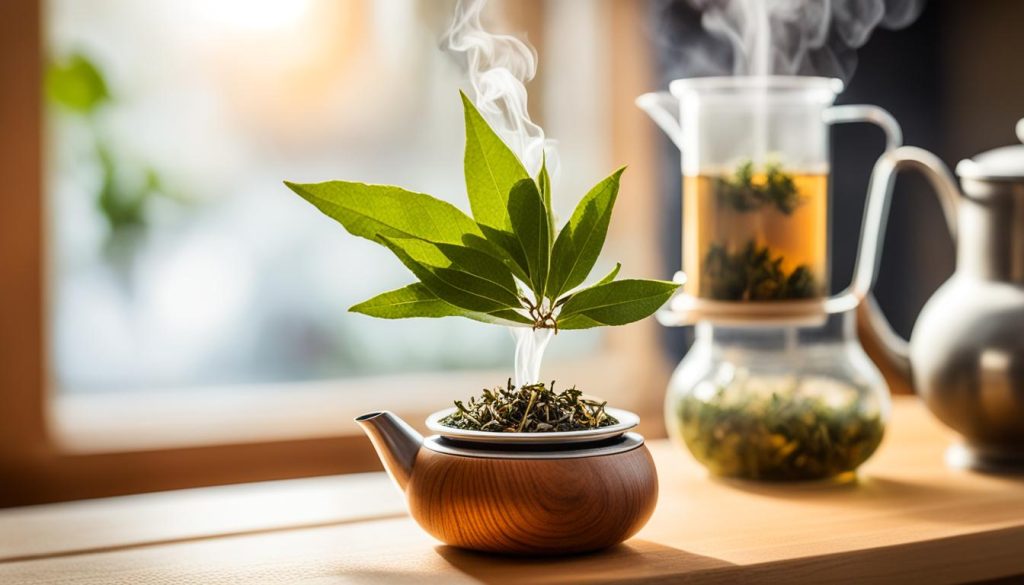
How to Brew Chai
Chai, a beloved Indian spiced tea, can be brewed in two different ways: as a traditional decoction or as an infusion. The choice between the two methods depends on personal preference and the desired flavor profile.
Making Chai Decoction
To make a chai decoction, start by combining water and milk in a saucepan and bring it to a simmer. Add the chai blend, which typically consists of black tea leaves, aromatic spices like cardamom, cinnamon, cloves, and ginger, and optional sweeteners such as sugar or honey. Allow the mixture to simmer for around 10-15 minutes, ensuring that the flavors infuse into the liquid. Strain the decoction into cups or a teapot, and serve hot.
Tip: Adjust the sweetness and spice levels according to taste. You can also experiment with different spice combinations to create your own unique chai blend.
Making Chai Infusion
If you prefer a quicker method, you can opt for brewing chai as an infusion. In this method, bring water to a boil and add the chai blend directly into the hot water. Let the mixture steep for about 3-5 minutes to extract the flavors. Strain the infused chai into cups or a teapot, and serve hot. This method allows for a more delicate flavor compared to the bolder taste of the decoction.
Tip: Steep the chai blend for a shorter duration if you prefer a milder taste, and for a longer duration if you want a stronger flavor. Adjust the amount of tea leaves and spices based on personal preference.
Chai can be enjoyed as is or paired with snacks like biscuits or savory treats. It’s a comforting and aromatic beverage that can be customized to suit individual tastes. Experiment with different brewing methods, spice combinations, and sweeteners to discover your perfect cup of chai.
| Brewing Method | Pros | Cons |
|---|---|---|
| Decoction |
|
|
| Infusion |
|
|
Note: The sweetness and spice levels can be adjusted in both brewing methods by adding or reducing the amount of sweeteners and spices used.
How to Brew Matcha Tea
If you’re a fan of the vibrant and rich flavors of matcha tea, mastering the art of brewing it is essential. Matcha tea, which is made from finely ground green tea leaves, offers a unique and invigorating experience. To achieve a frothy and creamy texture, follow these steps:
1. Measure the Matcha: Start by measuring the recommended amount of matcha powder using a bamboo scoop or a teaspoon. Traditionally, one teaspoon or about two grams of matcha is used per eight ounces of water.
2. Add Hot Water: Heat water to around 175°F to 180°F (79°C to 82°C), just below boiling point. Pour the hot water into a matcha bowl or cup, covering the matcha powder.
3. Whisk Until Frothy: Use a bamboo matcha whisk, also known as a chasen, to whisk the matcha powder and hot water vigorously in a back-and-forth motion until fully incorporated. Aim for a frothy consistency and a vibrant green color.
4. Enjoy Your Matcha: Once whisked, pour the prepared matcha into a cup or enjoy it directly from the matcha bowl. Savor the earthy flavors and the smooth texture of this traditional Japanese tea.
Optional Steps:
– Sift the Matcha: For an even smoother texture, you can sift the matcha powder before using it. This helps to remove any clumps and ensures a silky and consistent result.
– Try Iced Matcha Tea: If you prefer a refreshing and chilled version, you can use iced water instead of hot water. Simply combine the prepared matcha with ice cubes and cold water, then stir or shake vigorously to create an invigorating iced matcha tea.
With these simple steps, you can brew matcha tea like a pro and indulge in its unique flavors and health benefits.
